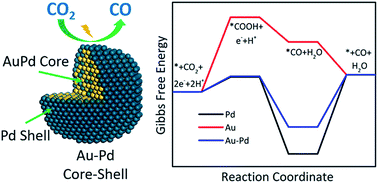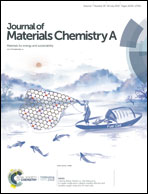Composition-dependent CO2 electrochemical reduction activity and selectivity on Au–Pd core–shell nanoparticles†
Abstract
Achieving a high faradaic efficiency and mass activity simultaneously on catalysts is critical in accelerating the practical application of CO2 electrochemical reduction. In this study, Au–Pd core–shell nanoparticles consisting of an ultrathin Pd-rich shell and an Au–Pd alloy core are developed by a simple one-pot synthesis method and evaluated for CO2-to-CO conversion. By adjusting the Au : Pd feeding ratio, the shell thickness and composition in the nanoparticle can be tuned. Significantly improved CO selectivity as compared to pure Au and Pd counterparts can be obtained on all the synthesized Au–Pd core–shell nanoparticles with a maximum faradaic efficiency of 96.7% at −0.6 V. The Au94Pd6 catalyst shows an ultrahigh mass activity of 99.8 A gPd+Au−1 for CO production at an overpotential of merely 390 mV. Combined in situ infrared absorption spectroscopy and density functional theory studies reveal that the easier desorption of *CO due to the more balanced *COOH/*CO adsorption energies on Au–Pd core–shell surfaces is responsible for the improved catalytic performance.



 Please wait while we load your content...
Please wait while we load your content...